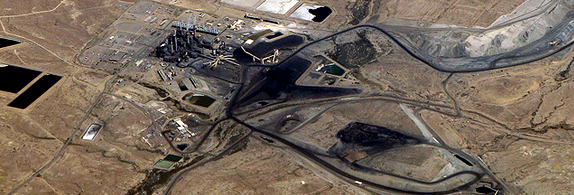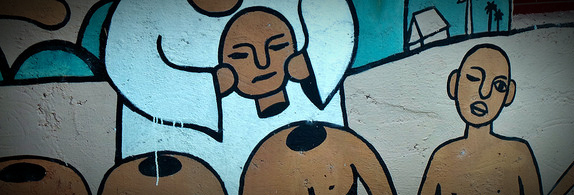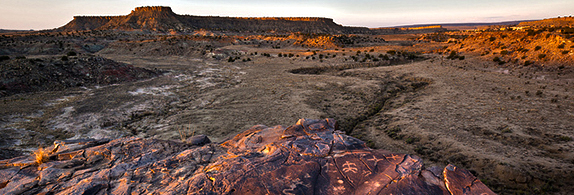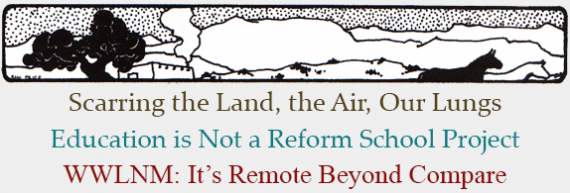Scarring the Land, Scarring the Air, Scarring Our Lungs

The modern economy of New Mexico is based on desecrating, scarifying, polluting, and ruining landscape and resources having no direct and immediate economic value – such as water and air.
This is not hyperbole, though some may consider it the ranting of an “extreme environmentalist.”
From the thousands of miles of roads and petroleum well sites that make up the seemingly endless lace of indelible scars that cover southeastern New Mexico to the vast green house gas methane cloud that covers much of the San Juan Basin in northwestern New Mexico to the empty platted roads of Rio Rancho to the wrecked water from fracking north and south, from the dense and dangerous smog pollution in the Four Corners to the callous contamination of water by the military industrial complex including the monumental Kirtland spill in Albuquerque to the potential scarring of landscape with roads for unbuildable housing in the proposed Santolina development on the southwest mesa of Albuquerque – making big money in New Mexico means pollution, scarring and wreckage of land in an economy either dependent on the military or constructed around an ideology of inevitable and endless growth. Anything that gets in the way is trashed.
Of course it doesn’t have to be this way. This is our choice. There are other ways to run the world. The current rulers are doing everything they can to stop innovation, slow down alternatives, and block new thinking.
I’ve heard it said that “all” powerful civilizations of the past have wrecked their land and polluted their unrenewable resources. That’s just the way it is and it really isn’t so bad. Such talk is the last canard of desperate oligarchs who see the handwriting on the wall, even if it’s only in their nightmares.
As we saw in Margaret Randall’s review of photographer Edward Ranney’s book The Lines (with an essay by Lucy Lippard), landscape altering feats of engineering from the ancient past have meanings that are available to us only by conjecture and comparative ethnology. As at Chaco Canyon, with its extensive road system developed over a period of 200 to 300 years from perhaps 850 AD to 1150 AD, built by hand with wood and stone tools, the “lines” in the landscape made by the Nazca culture some 2000 years ago in southern Peru are utterly unlike the scarification of the landscape in contemporary times. Nazca and Chaco alterations of the landscape were not scars. While some were made as trade routes, many it seems were built as avenues, maps, or compasses leading to higher powers.
In the beginning days of 2015, we know New Mexico’s environment is in for hard times, both by disasters of policy and politics and by pollution undermining survivability in a time of chronic drought which is showing every sign of becoming the “new normal” weather pattern for years to come. Snow in the Rockies and in the California Sierra Nevadas is hit or miss, though anything is a godsend these days with mounting pressures on the Colorado River system and the Rio Grande from decades of profligate use by overgrown cities and outdated irrigation methods.
The now ruling Republican majority in New Mexico, and its fellow travelers in the Democratic party, consider the environment to be a throwaway sacrifice at the alter of low paying and dangerous jobs that make a few filthy rich and blight the lives of countless others, much as it blights the landscape.
We know that the Public Regulation Commission (PRC) is considering this week PNM’s plan to cut back on air pollution, a plan the Conservation Voters of New Mexico thinks “would lock our state into risky energy sources – like coal and nuclear – for decades,” a plan that “has no requirements for the utility to increase renewable energy, like wind and solar.”
Last week the Washington Post published yet another story that gives New Mexico an environmental black eye about what it called a “Delaware-size gas plume” over the Four Corners that “illustrates the cost of leaking methane.” The greenhouse gas escaping from “leaks” from “the 40,000 gas wells” and “drilling rigs, compressors and miles of pipeline snaking across the badlands.” Of course, what the Post considers “badlands” we consider the San Juan Basin with its families and their homes, its polluted San Juan River and its horrendous air pollution that spreads into the communities of Cortez, Durango and Pagosa Springs in southern Colorado.
Anyone who reads the New Mexico Mercury, and keeps up with environmental reporting around the state, knows what a terrible condition our air and water are in and how vigorously those who have caused that degradation deny its very existence and consider even talking about it “bad form” approaching unpatriotic hysteria. As bad air scars the lungs of those who live around the Four Corners and bad water threatens the long term health of all of us in New Mexico, as well as our economic and social viability, and as drought continues to squeeze the luxurious excess out of most cities in the West, 2015 becomes, in my mind, a turning point year.
It’s a year for more and more people to leave the realms of economic fantasy and denial, to oppose the dreadnaught of the status quo, to demand an end to the scarring of our land, the polluting of our air, and the souring and poisoning of our water. It’s time to say “no more” to ill health that is induced by environmental pollution. An end to such things is not, of course, in sight. It won’t come to pass this year. But really it is now or never. And we better start now, seriously, loudly, and consistently or we’ll never have a chance.
Education is Not a Reform School Project

Waiting in the dentist’s office the other day, trying to focus on reading while being bombarded with TV game shows and noise from ceaseless chattering on cell phones, I got to thinking about what it must be like for older people in nursing homes to be surrounded by the din of ludicrous commerce and brain dead distractions from the great wasteland of television and corporate media.
Almost immediately I found my mind moving from nursing homes to school rooms, corporate school rooms, school rooms full of the numbing stress of constant test-taking that’s on the road to replacing the foundations of a liberal education and replacing the joyous effort of learning and “student initiated inquiry” with a drudgery that resembles child labor in a reformatory.
Nursing homes that drive people senseless from the boredom of warehousing, and reformatory education that creates worker widgets who can be bossed around and underpaid and never be expected to make a contribution to a business other than their automaton labor, are of the same species.
We know that corporate “teaching” and the widgetizing of students in New Mexico this year will make ever more devastating raids on taxpayer coffers to have us subsidize corporate profits while being robbed blind ourselves. 2015 will be a year that those of us who see learning as one of the great human delights will have to fight harder than ever to support great teachers and administrators who still believe that a liberal education best equips young people to be citizens and guardians of a free society, as well as job holders.
The Association of American Colleges and Universities describes a liberal education as an “approach to learning that empowers individuals and prepares them to deal with complexity, diversity, and change….A liberal education helps students develop a sense of social responsibility, as well as strong and transferable intellectual and social skills such as communication, analytical and problem solving skills, and a demonstrated ability to apply knowledge and skills in real world settings.”
This seems to me to be the antithesis of corporate, prepackaged learning, learning to the test, not learning for the joy, meaning, and adventure of it.
The struggle to preserve and advance a relevant educational system has been an uphill battle for years. Bean counters have crammed classrooms like sardine tins making it next to impossible for good teachers to inspire students and lead them into the richness of a life of learning by the example of their own intellectual lives. If you see learning as a natural and unstoppable human activity, and curiosity as our species’ greatest asset, you’ll find yourself so far out of the mainstream, even with university educators, that you’ll lose all respect for “education” that’s been morphed into “training.”
To turn education into a problem is like turning walking into something you have to be taught. But I’m sure we’ll see more of that kind of thinking this year. Companies can’t make money if learning is as simple as wanting to know about the world. They have to make it a hardship full of stress and angst with impossible goals and authoritarian pressures. What better way than to create a society of people who are easily controlled, hoodwinked, bamboozled and distracted by propaganda trickery, spectator sports and a political economy rooted in foul arts of inducing people to want products they do not need.
A liberal education that encourages independence, self-discipline, the love of asking of questions and self-motivated research helps young people become self-starters who value their own minds and a developing sense of purpose and, with a sense of fairness and justice in the world, value the minds and freedoms of others.
That’s always been the alternative to a privatized authoritarian education system that promises to pop out good employees, docile and replaceable, who can read the instructions and take directions and ask no questions.
Why We Love New Mexico: It’s Remote Beyond Compare

In the depth of winter in New Mexico when icy winds and snows intensify feelings of solitude and the precarious sense of safety that often comes with it (if you can stay warm, hole up and think and read), you can get an idea of what Don Diego de Vargas meant in the 1690s when he called our landscape “remote beyond compare.”
Big city people can find our remoteness unsettling, sometimes even depressing. New Mexico in winter is a place for introverts. It allows for a kind of introspection that comes only with being secluded and very far away. It’s akin to how children might feel when they think no one knows where they are. Freedom is let loose. We’re in New Mexico. If we shut off our TVs and radios and phones, we can be in a winter as far away as a thousand years.
History inhabits us. What must it have been like to be in Chaco Canyon in the winter of 900 AD? How warm can you get wearing rabbit skin robes, bundled up in kivas, or going out into the snow in yucca foot gear to find wood? Or imagine being a conquistador or a farmer during the little ice age in the 16th and 17th centuries in the West, trying to find graze for your livestock and food for yourselves.
Out on the ditches, or in the Bosque, the winter landscape is so dominant and beautiful in its frozen desolation it can drive even deep worries from your head.
The cold cleanses the present moment of so many distractions. Keeping warm and moving are what matters. And when you’re finally inside and warm, the insulation of the snow makes it seem you really are too far away to be reached by any bother.
New Mexico, no matter what the season, is so magnetically beautiful that, if you don’t lose your focus, being remote beyond compare here is rather like what one might imagine the long dreamed of valley of our deep content could be.
I’ve lived here through more than half a century of winters. One January in the early l970s it got to 18 below zero at night and didn’t get above freezing for almost two weeks. We were ice bound, snow bound, without running water, but the heater worked and the lights shown bright. We were lucky to be warm. During those two weeks ideas for books arose, columns were composed, and the camaraderie of winter hardship set long friendships in motion.
As the state’s population continues to shrink, approaching under two million people for the first time in over a decade, open spaces expand and winter encloses us in possibilities as it keeps the world and its horrors at bay for a while and gives us the supreme luxury of loving and admiring, without reservation, this New Mexican place that we call home.
(Photos: San Juan Generating Station aerial by Doc Searls; production line graffiti by Gareth Williams; Ojito Wilderness by Bureau of Land Management / All CC)




Responses to “Provincial Matters, 1-5-2015”